Does Online Public Opinion Regarding Swine Epidemic Diseases Influence Fluctuations in Pork Prices?—An Analysis Based on TVP-VAR and LDA Models
Abstract
1. Introduction
2. Literature Review
2.1. Analysis of Influencing Factors of Pork Price Fluctuation
2.2. Online Public Opinion of Public Emergencies
2.3. The Relationship Between Online Public Opinion of Public Emergencies and Agricultural Market Prices
3. Theoretical Analysis and Research Hypothesis
3.1. Theoretical Analysis
3.1.1. Online Information Dissemination
3.1.2. Online Emotional Contagion
3.1.3. Online Public Opinion Guidance
3.2. Research Hypotheses
4. Materials and Methods
4.1. Data
4.2. Variable Selection
4.2.1. Pork Price Fluctuation
4.2.2. Public Attention
4.2.3. Negative Sentiment
4.3. Model
4.3.1. Time-Varying Parameter Vector Autoregression (TVP-VAR) Model
4.3.2. Latent Dirichlet Allocation (LDA) Model
5. Results
5.1. Estimation of Selected Parameters
5.1.1. Stationarity Test
5.1.2. Optimal Lag Order
5.1.3. Parameter Estimation
5.2. Impulse Response Analysis
5.2.1. Equal-Interval Impulse Response Results Analysis
5.2.2. Impulse Response Analysis at Different Times
5.3. Robustness Test
5.4. Further Discussion
6. Conclusions
Author Contributions
Funding
Institutional Review Board Statement
Data Availability Statement
Conflicts of Interest
References
- Fu, L.; Zhang, H. Analysis of Factors Influencing Small-Scale Agricultural Product Prices from the Perspective of the Online Public—A Case Study of China. Front. Sustain. Food Syst. 2024, 8, 1355853. [Google Scholar] [CrossRef]
- Zhao, Y.; Han, L.; Sang, H.; Yang, P.; Hou, Y.; Xiao, Y. Two Genotypes of H3N2 Swine Influenza Viruses Identified in Pigs from Shandong Province, China. Front. Cell. Infect. Microbiol. 2024, 14, 1517023. [Google Scholar] [CrossRef]
- Perez-Acle, T.; Ravello, C.; Rosemblatt, M. Are We Cultivating the Perfect Storm for a Human Avian Influenza Pandemic? Biol. Res. 2024, 57, 96. [Google Scholar] [CrossRef]
- Nguyen, T.T.; Mai, T.N.; Dang-Xuan, S.; Nguyen-Viet, H.; Unger, F.; Lee, H.S. Emerging Zoonotic Diseases in Southeast Asia in the Period 2011-2022: A Systematic Literature Review. Vet. Q. 2024, 44, 1–15. [Google Scholar] [CrossRef]
- Kim, G.; Kim, S.-J.; Kim, J.-H.; Kim, Y.-K.; Jheong, W.-H. Resurgence of Type III IGR Between I73R and I329L in Wild Boars with African Swine Fever in South Korea in 2023. Transbound. Emerg. Dis. 2025, 2025, 2524367. [Google Scholar] [CrossRef]
- Soon, B.M.; Kim, W. The Impact of African Swine Fever News Sentiment on the Korean Meat Market. PLoS ONE 2023, 18, e0286520. [Google Scholar] [CrossRef]
- Griffin, T.M.; Hagerman, A.D.; Lambert, D.M.; Inman, R. Media Content, African Swine Fever, a Trade War, and U.S. Lean Hog Futures. J. Agric. Appl. Econ. 2024, 56, 530–543. [Google Scholar] [CrossRef]
- Kashyap, P.; Suter, J.F.; McKee, S.C. Measuring Changes in Pork Demand, Welfare Effects, and the Role of Information Sources in the Event of an African Swine Fever Outbreak in the United States. Food Policy 2024, 126, 102672. [Google Scholar] [CrossRef]
- Wei, X.; Lin, W.; Hennessy, D.A. Biosecurity and Disease Management in China’s Animal Agriculture Sector. Food Policy 2015, 54, 52–64. [Google Scholar] [CrossRef]
- Li, Y.; Robertson, I. The Epidemiology of Swine Influenza. Anim. Dis. 2021, 1, 21. [Google Scholar] [CrossRef]
- Li, H.; Hu, C.; Lu, Z.; Li, M.; Guo, X. African Swine Fever and Meat Prices Fluctuation: An Empirical Study in China Based on TVP-VAR Model. J. Integr. Agric. 2021, 20, 2289–2301. [Google Scholar] [CrossRef]
- Lv, X.; Meng, J.; Wu, Q. Dynamic Influence of Network Public Opinions on Price Fluctuation of Small Agricultural Products Based on NLP-TVP-VAR Model—Taking Garlic as an Example. Sustainability 2022, 14, 8637. [Google Scholar] [CrossRef]
- Pan, D.; Yang, J.; Zhou, G.; Kong, F. The Influence of COVID-19 on Agricultural Economy and Emergency Mitigation Measures in China: A Text Mining Analysis. PLoS ONE 2020, 15, e0241167. [Google Scholar] [CrossRef]
- Pang, J.; Yin, J.; Lu, G.; Li, S. Supply and Demand Changes, Pig Epidemic Shocks, and Pork Price Fluctuations: An Empirical Study Based on an SVAR Model. Sustainability 2023, 15, 13130. [Google Scholar] [CrossRef]
- Orozco-Cirilo, S.; Manuel Vargas-Canales, J.; Ernesto Medina-Cuellar, S.; Antonio Bautista, J. Mexican pork price forecast, based on WTI crude oil and Corn and Soybean grains. Rev. Cient.-Fac. Cienc. Vet. 2023, 33, 1–8. [Google Scholar] [CrossRef]
- Wan, W.; Tao, J. The Impact of Food Safety Scandals on Pork Prices from Consumer Concern Perspective: Evidence from China. Front. Sustain. Food Syst. 2023, 7, 1270705. [Google Scholar] [CrossRef]
- Noda, H.; Kyo, K. Dynamic Relationships among Changes in Prices of Beef, Pork, and Chicken in Japan: A Bayesian Approach. J. Agric. Food Res. 2023, 11, 100464. [Google Scholar] [CrossRef]
- Guo, J.; Tanaka, T. Potential Factors in Determining Cross-Border Price Spillovers in the Pork Sector: Evidence from Net Pork-Importing Countries. Humanit. Soc. Sci. Commun. 2022, 9, 4. [Google Scholar] [CrossRef]
- Jin, T.; Li, L. An Empirical Analysis of Pork Price Fluctuations in China with the Autoregressive Conditional Heteroscedasticity Model. Cienc. Rural 2024, 54, e20220197. [Google Scholar] [CrossRef]
- Jurkenaite, N. Pork Market Price Transmission During the COVID-19 Pandemic: The Lithuanian Case. Montenegrin J. Econ. 2024, 20, 53–62. [Google Scholar] [CrossRef]
- Yang, Q.; Qiao, S.; Ying, R. Agricultural Industrial Scale, Price Random Fluctuation, and Profitability Levels: Evidence from China’s Pig Industry. Front. Sustain. Food Syst. 2024, 8, 1291743. [Google Scholar] [CrossRef]
- Popescu, A. Pork Market Crisis in Romania: Pig Livestock, Pork Production, Consumption, Import, Export, Trade Balance and Price. Sci. Pap.-Ser. Manag. Econ. Eng. Agric. Rural Dev. 2020, 20, 461–474. [Google Scholar]
- Su, Y.; Qu, Y.; Kang, Y. Online Public Opinion and Asset Prices: A Literature Review. Data Sci. Financ. Econ. 2021, 1, 60–76. [Google Scholar] [CrossRef]
- Liu, T.; Hu, X.; Dong, Q. Generation Paths of Online Public Opinion Impact in Public Health Emergency: A Fuzzy-Set Qualitative Comparative Analysis Based on Chinese Data. Front. Public Health 2024, 12, 1404587. [Google Scholar] [CrossRef]
- Qin, M.; Lu, W. The Influence of Public Sentiment on the Price of Aquatic Products under the Influence of Nuclear Wastewater Discharge in Japan. Mar. Policy 2024, 170, 106384. [Google Scholar] [CrossRef]
- Bollen, J.; Mao, H.; Pepe, A. Modeling Public Mood and Emotion: Twitter Sentiment and Socio-Economic Phenomena. In Proceedings of the International AAAI Conference on Web and Social Media, Online, 7–10 June 2021; Volume 5, pp. 450–453. [Google Scholar] [CrossRef]
- Yadavalli, A.; Jones, K. Does Media Influence Consumer Demand? The Case of Lean Finely Textured Beef in the United States. Food Policy 2014, 49, 219–227. [Google Scholar] [CrossRef]
- Hou, K.; Hou, T.; Cai, L. Public Attention about COVID-19 on Social Media: An Investigation Based on Data Mining and Text Analysis. Personal. Individ. Differ. 2021, 175, 110701. [Google Scholar] [CrossRef]
- Zhou, Q.; Jing, M. Multidimensional Mining of Public Opinion in Emergency Events. Electron. Libr. 2020, 38, 545–560. [Google Scholar] [CrossRef]
- Yang, X.; Cao, J.; Liu, Z.; Lai, Y. Environmental Policy Uncertainty and Green Innovation: A TVP-VAR-SV Model Approach. Quant. Financ. Econ. 2022, 6, 604–621. [Google Scholar] [CrossRef]
- Yi, L.; Tao, J.; Tan, C.; Zhu, Z. Avian Influenza, Public Opinion, and Risk Spillover: Measurement, Theory, and Evidence from China’s Broiler Market. Sustainability 2019, 11, 2358. [Google Scholar] [CrossRef]
- Hassouneh, I.; Radwan, A.; Serra, T.; Gil, J.M. Food Scare Crises and Developing Countries: The Impact of Avian Influenza on Vertical Price Transmission in the Egyptian Poultry Sector. Food Policy 2012, 37, 264–274. [Google Scholar] [CrossRef]
- Kim, S.; Sung, K.H.; Ji, Y.; Xing, C.; Qu, J.G. Online Firestorms in Social Media: Comparative Research between China Weibo and USA Twitter. Public Relat. Rev. 2021, 47, 102010. [Google Scholar] [CrossRef]
- Zhang, F.; Tang, Q.; Chen, J.; Han, N. China Public Emotion Analysis under Normalization of COVID-19 Epidemic: Using Sina Weibo. Front. Psychol. 2023, 13, 1066628. [Google Scholar] [CrossRef] [PubMed]
- Gallagher, C. How “cocooning” as a Public Health Measure Was Reported during the COVID-19 Crisis. Administration 2022, 70, 33–57. [Google Scholar] [CrossRef]
- Simeone, M.; Scarpato, D. Sustainable Consumption: How Does Social Media Affect Food Choices? J. Clean. Prod. 2020, 277, 124036. [Google Scholar] [CrossRef]
- Herrando, C.; Jimenez-Martinez, J.; Martin-De Hoyos, M.J.; Constantinides, E. Emotional Contagion Triggered by Online Consumer Reviews: Evidence from a Neuroscience Study. J. Retail. Consum. Serv. 2022, 67, 102973. [Google Scholar] [CrossRef]
- Askay, D.A. Silence in the Crowd: The Spiral of Silence Contributing to the Positive Bias of Opinions in an Online Review System. New Media Soc. 2014, 17, 1811–1829. [Google Scholar] [CrossRef]
- Zhang, L.; Wei, J.; Boncella, R.J. Emotional Communication Analysis of Emergency Microblog Based on the Evolution Life Cycle of Public Opinion. Inf. Discov. Deliv. 2020, 48, 151–163. [Google Scholar] [CrossRef]
- Rieger, J.; Weible, D.; Anders, S. “Why Some Consumers Don’t Care”: Heterogeneity in Household Responses to a Food Scandal. Appetite 2017, 113, 200–214. [Google Scholar] [CrossRef]
- Rathi, M.; Majumdar, A.; Rathi, S. Unraveling Prosumption Behavior for Online Reviews during Environmental Uncertainty: A Stimulus-Response Perspective. Inf. Syst. Front. 2024. [Google Scholar] [CrossRef]
- Ren, J.; Dong, H.; Padmanabhan, B.; Nickerson, J.V. How Does Social Media Sentiment Impact Mass Media Sentiment? A Study of News in the Financial Markets. J. Assoc. Inf. Sci. Technol. 2021, 72, 1183–1197. [Google Scholar] [CrossRef]
- Hou, L.-L. Impact of COVID-19 on Latent Emissiveness of Residents in China: Based on the X-12-ARIMA Additive Seasonal Adjustment Model. J. Comput. Methods Sci. Eng. 2021, 21, 1591–1604. [Google Scholar] [CrossRef]
- Sufyanullah, K.; Ahmad, K.A.; Sufyan Ali, M.A. Does Emission of Carbon Dioxide Is Impacted by Urbanization? An Empirical Study of Urbanization, Energy Consumption, Economic Growth and Carbon Emissions—Using ARDL Bound Testing Approach. Energy Policy 2022, 164, 112908. [Google Scholar] [CrossRef]
- Wang, K.-H.; Zhao, Y.-X.; Jiang, C.-F.; Li, Z.-Z. Does Green Finance Inspire Sustainable Development? Evidence from a Global Perspective. Econ. Anal. Policy 2022, 75, 412–426. [Google Scholar] [CrossRef]
- Blei, D.M.; Ng, A.Y.; Jordan, M.I. Latent Dirichlet Allocation. J. Mach. Learn. Res. 2003, 3, 993–1022. [Google Scholar] [CrossRef]

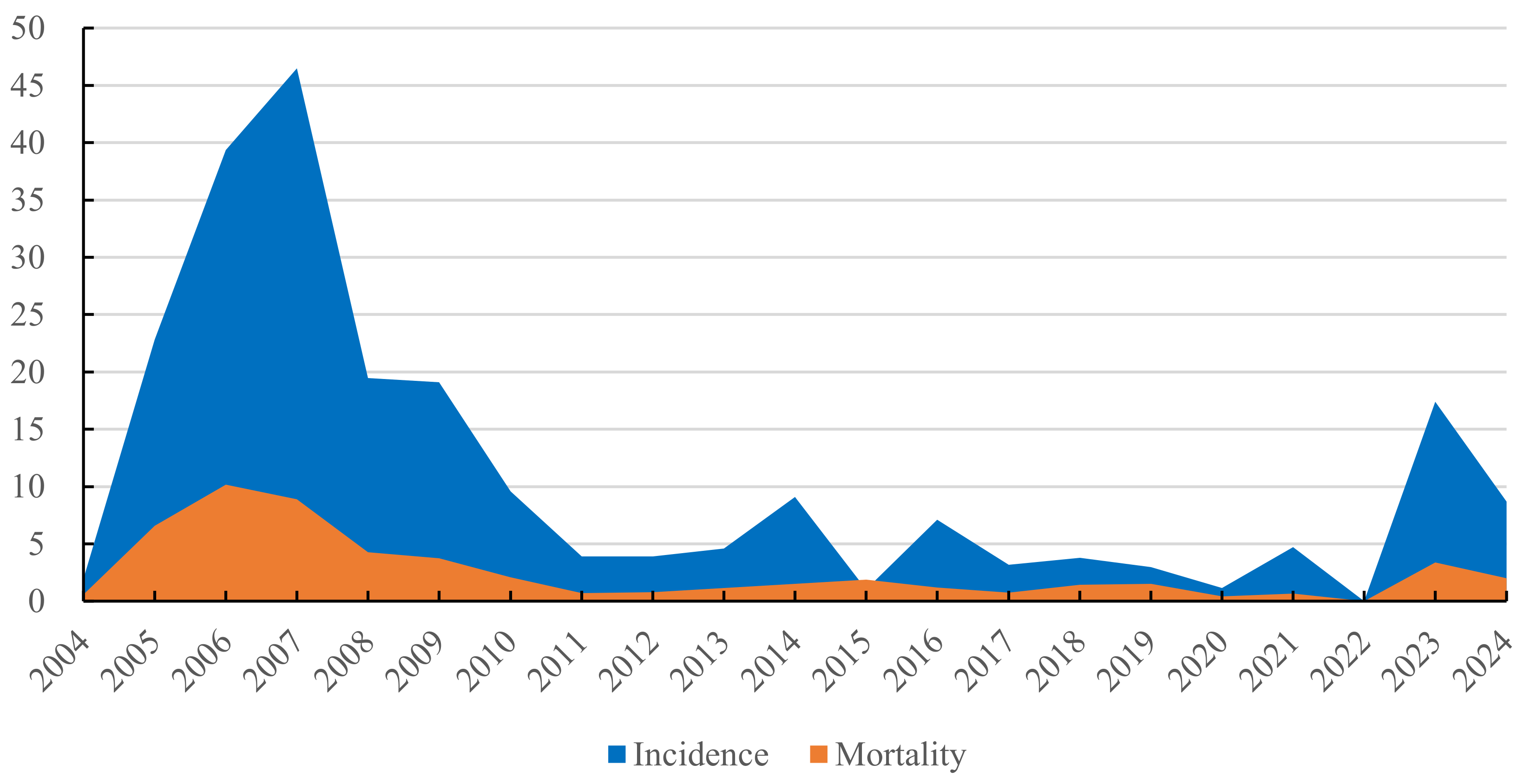

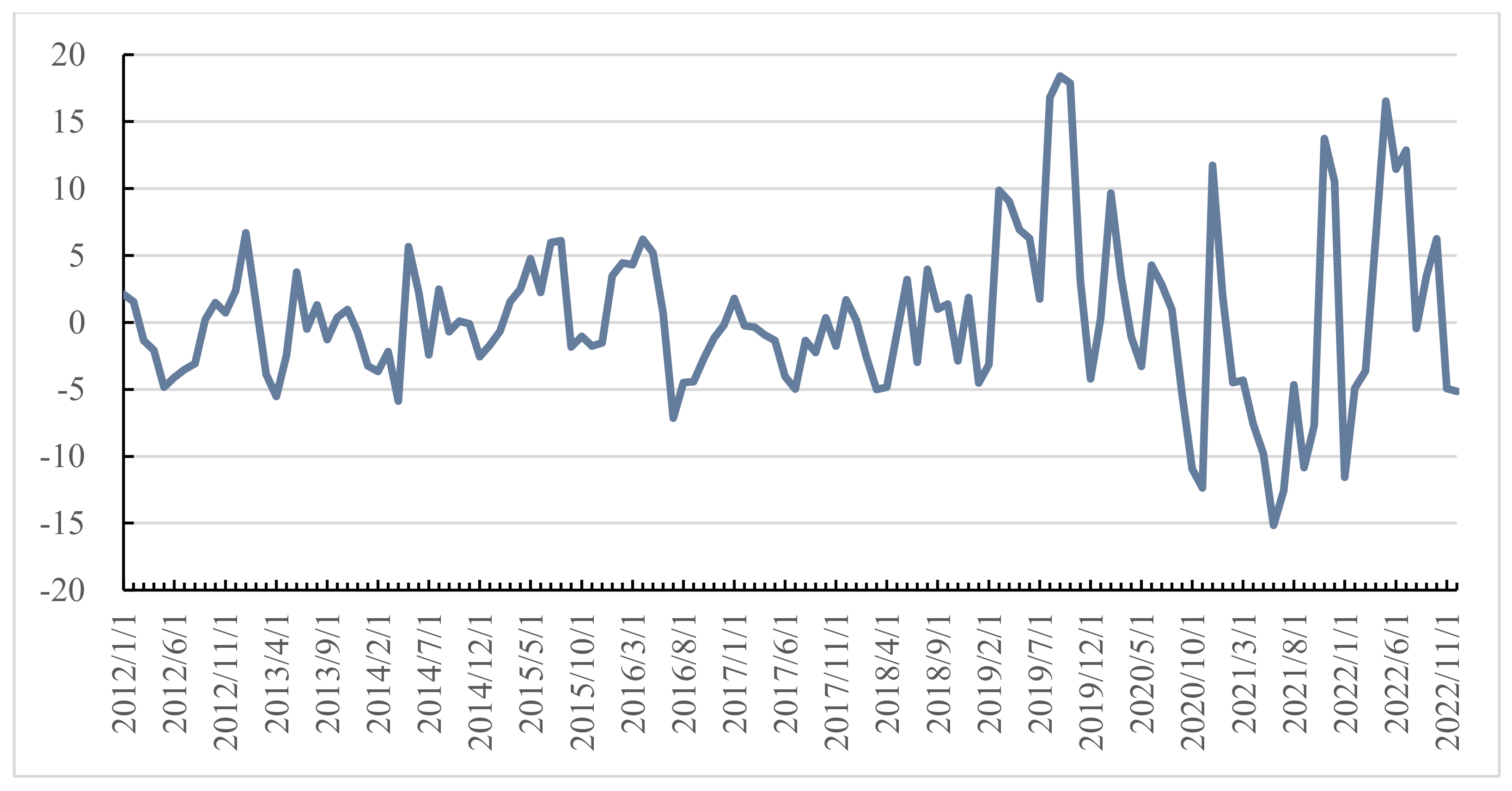
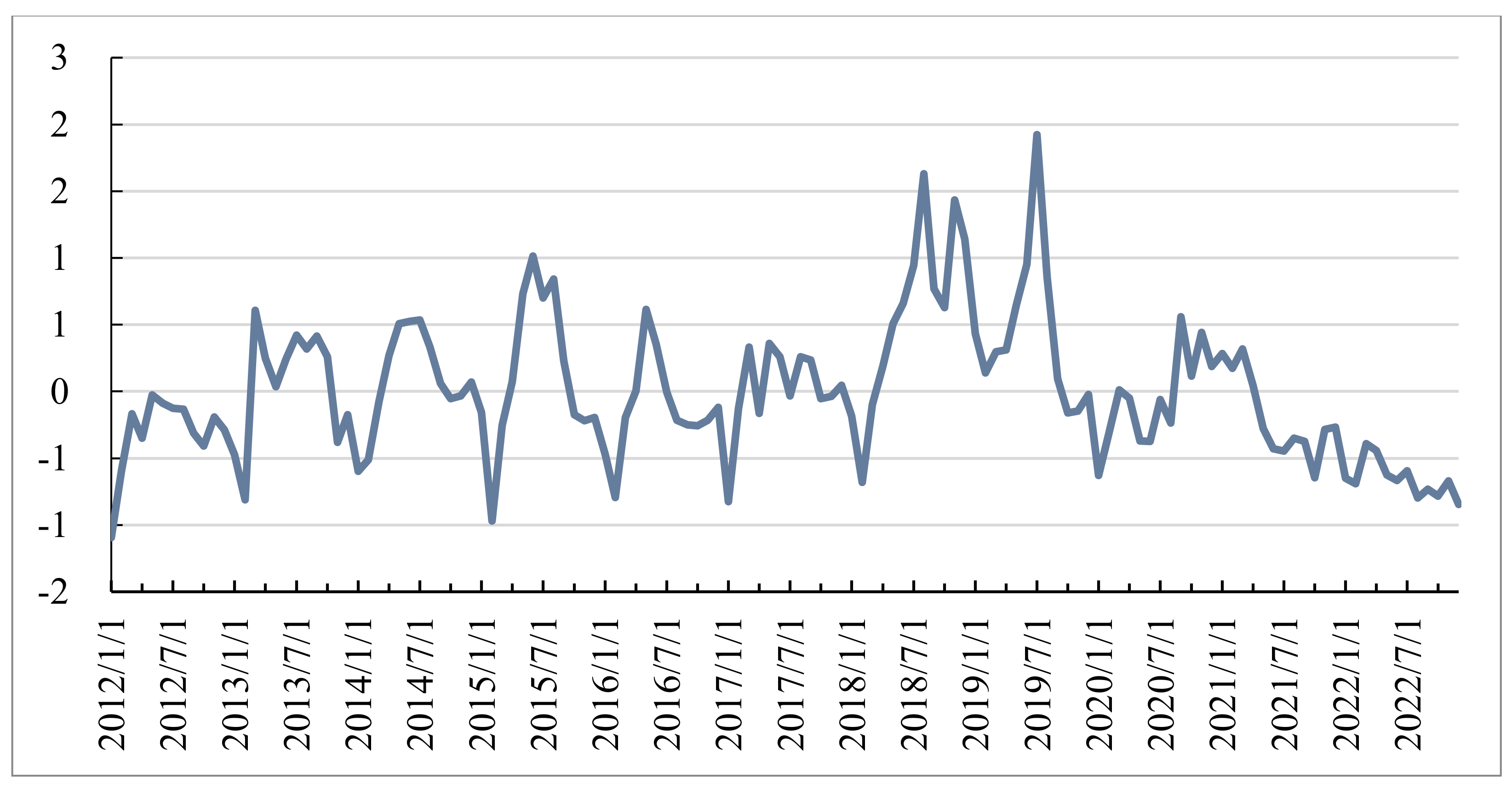
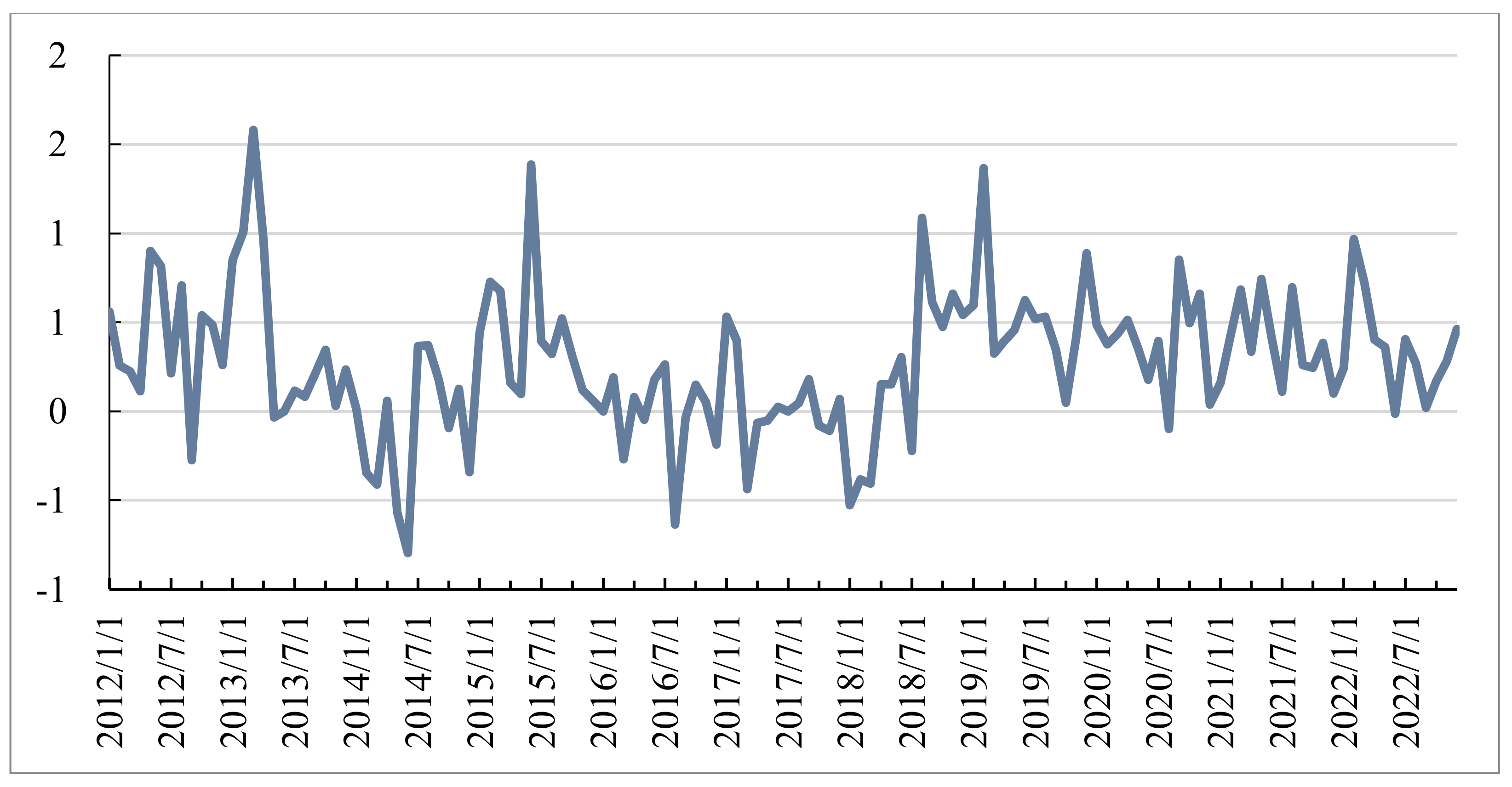


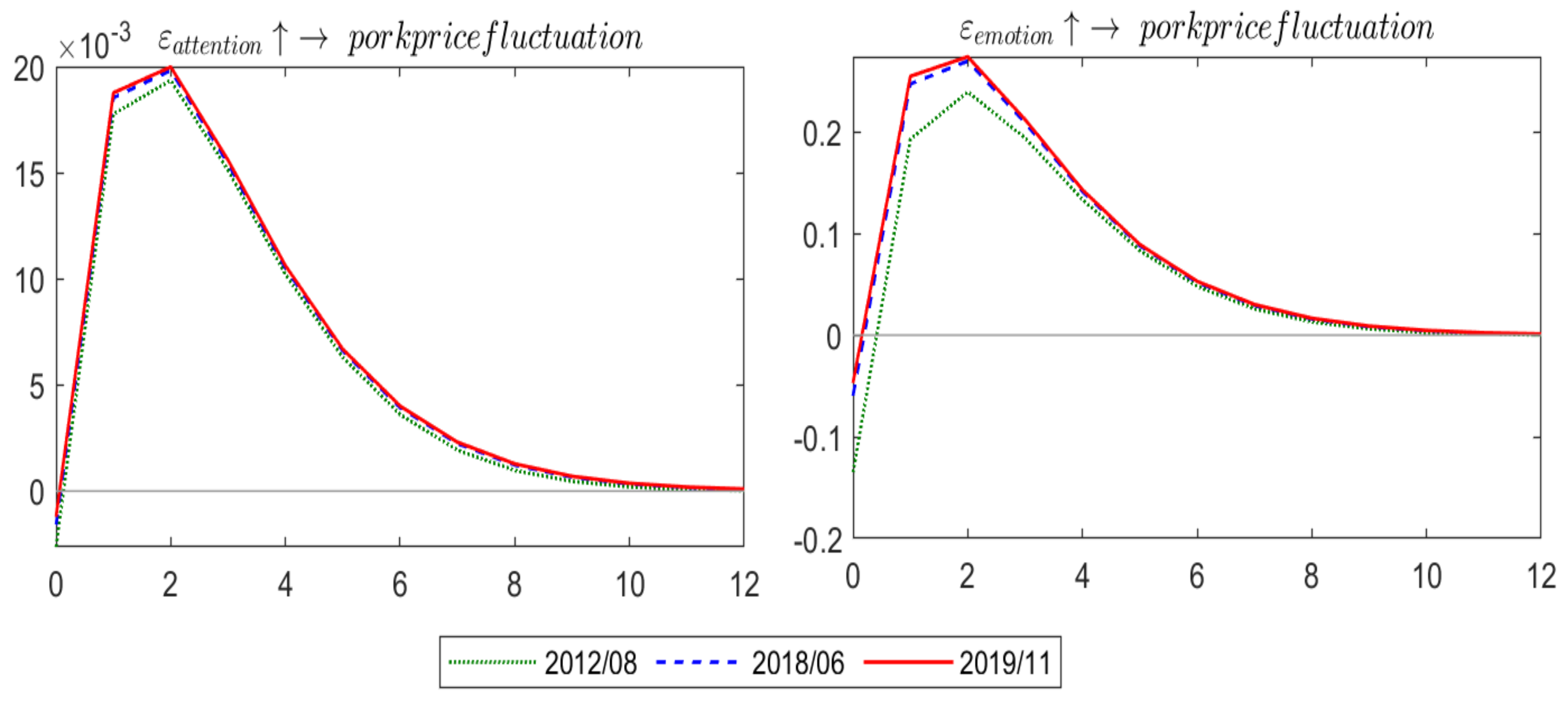


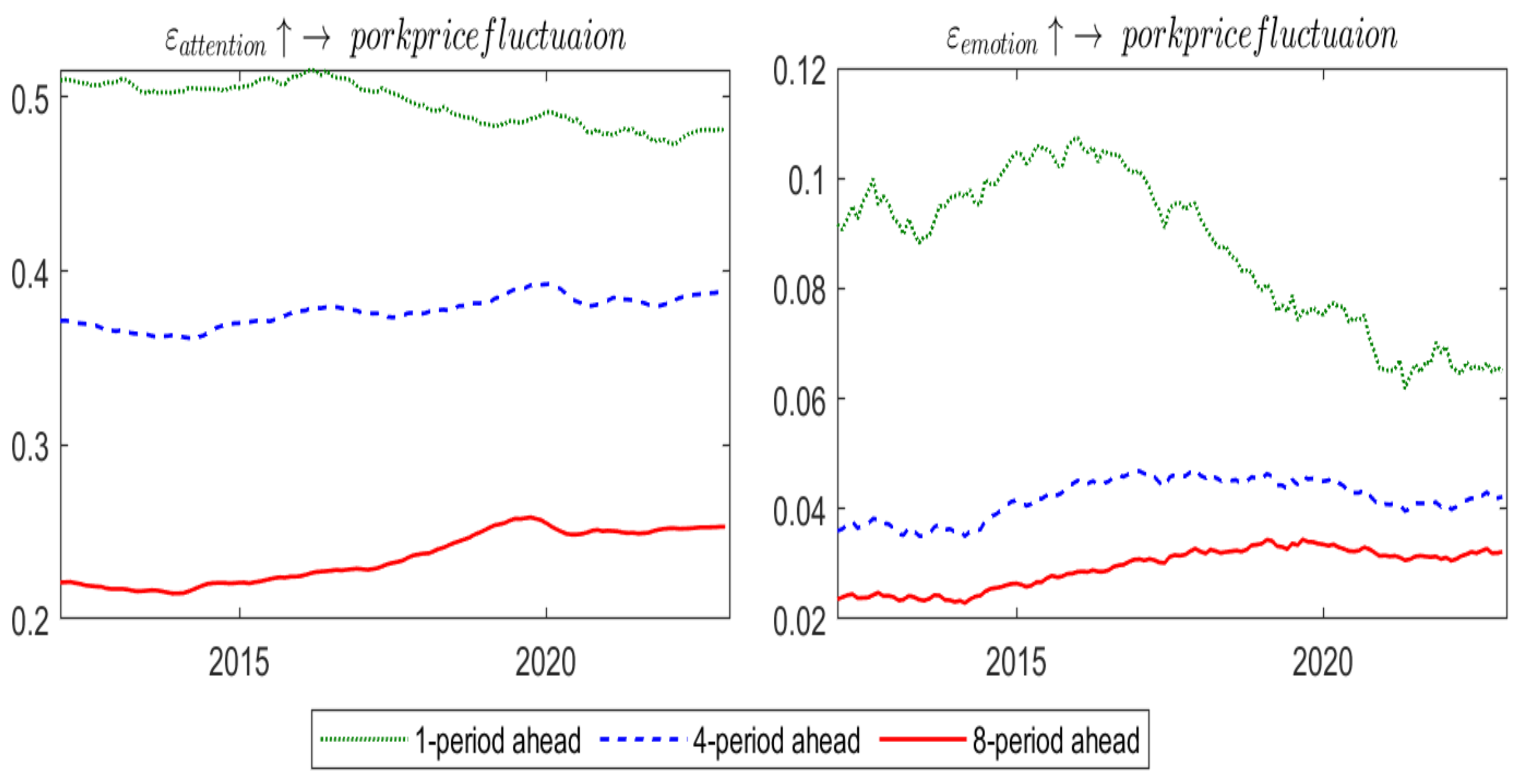
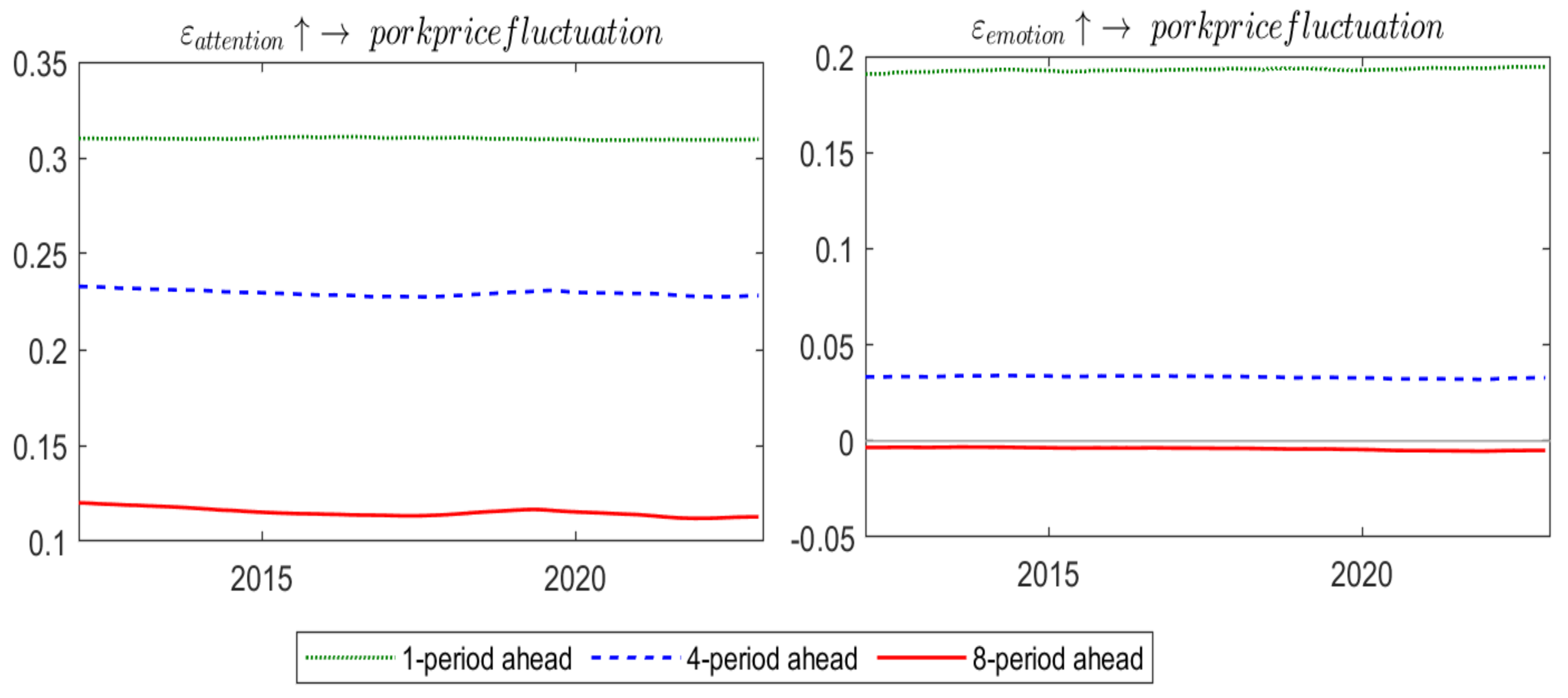
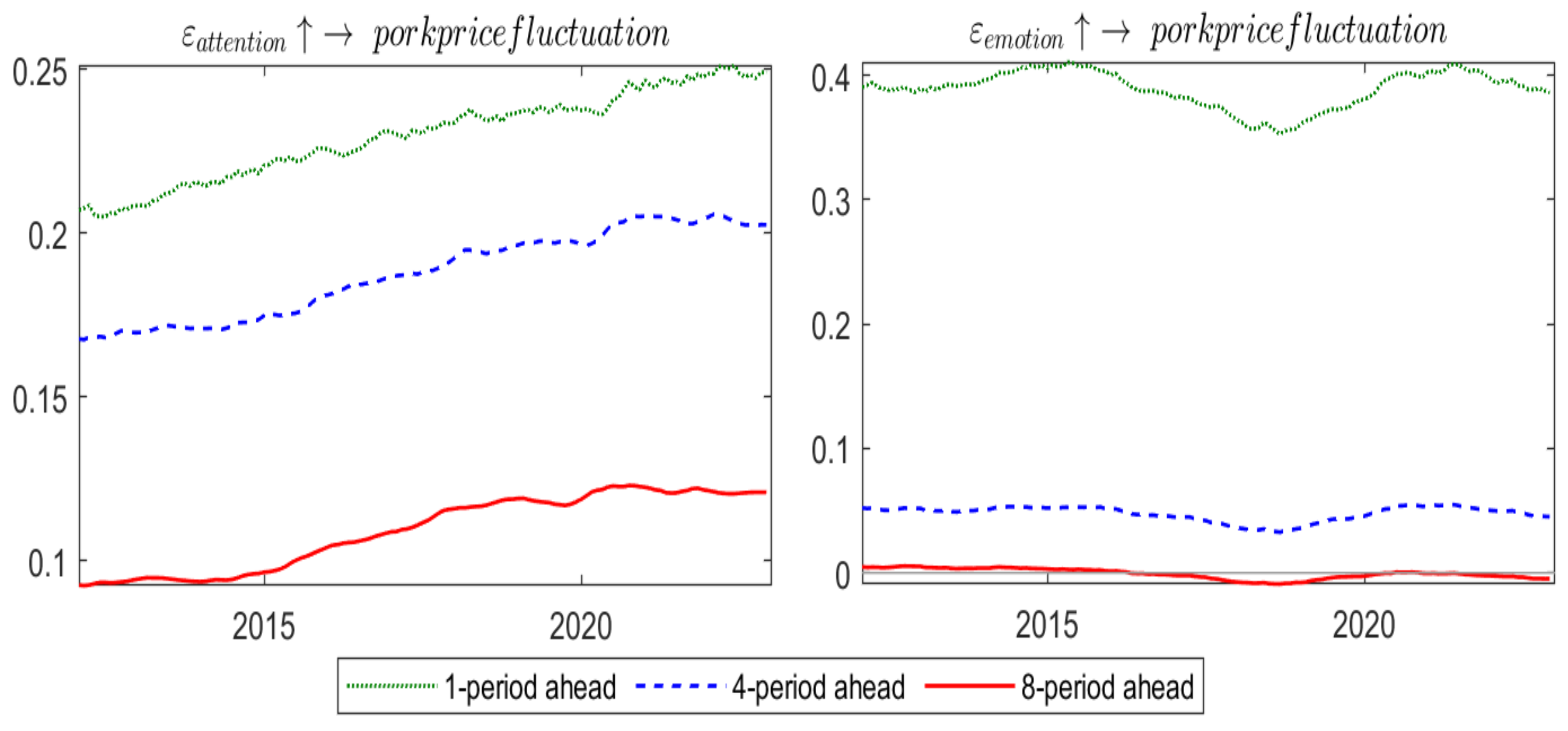
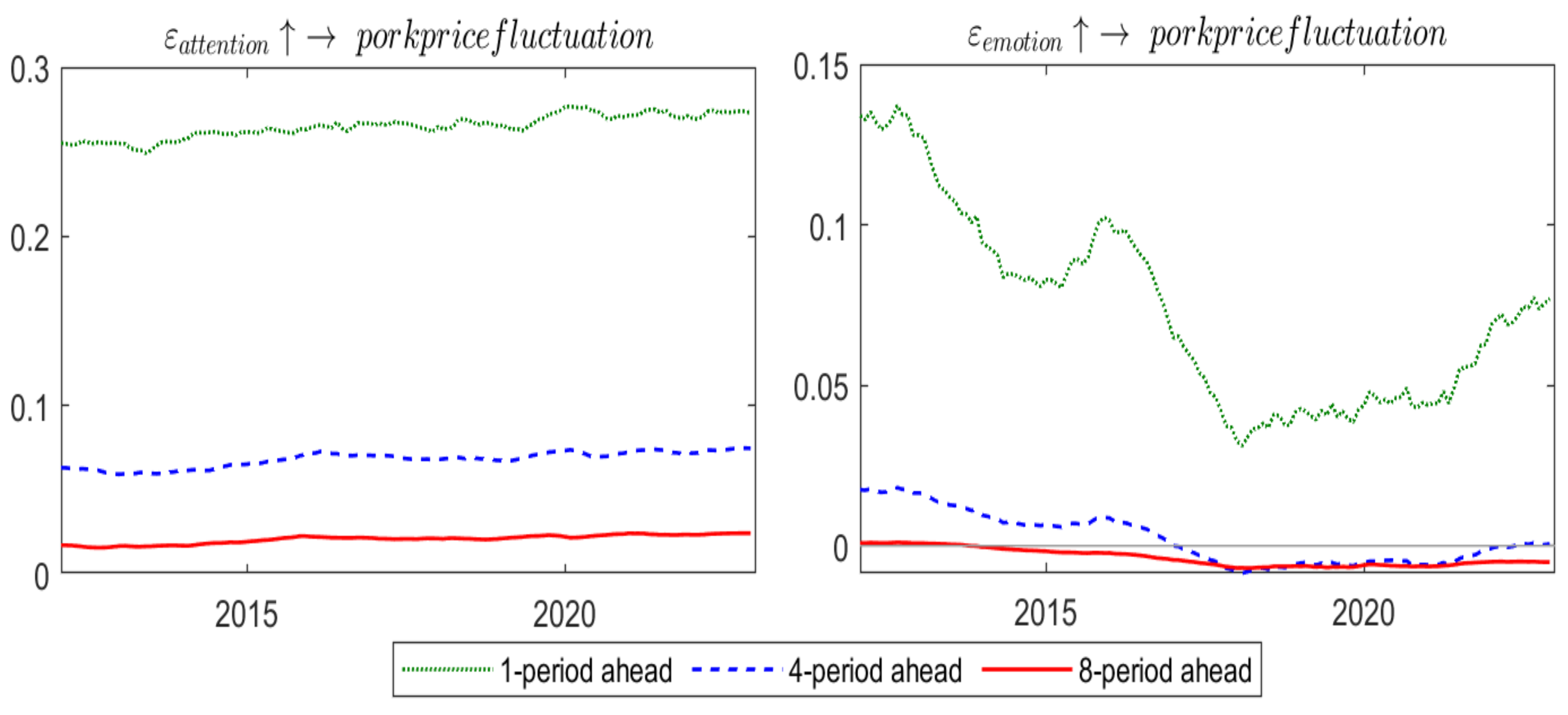
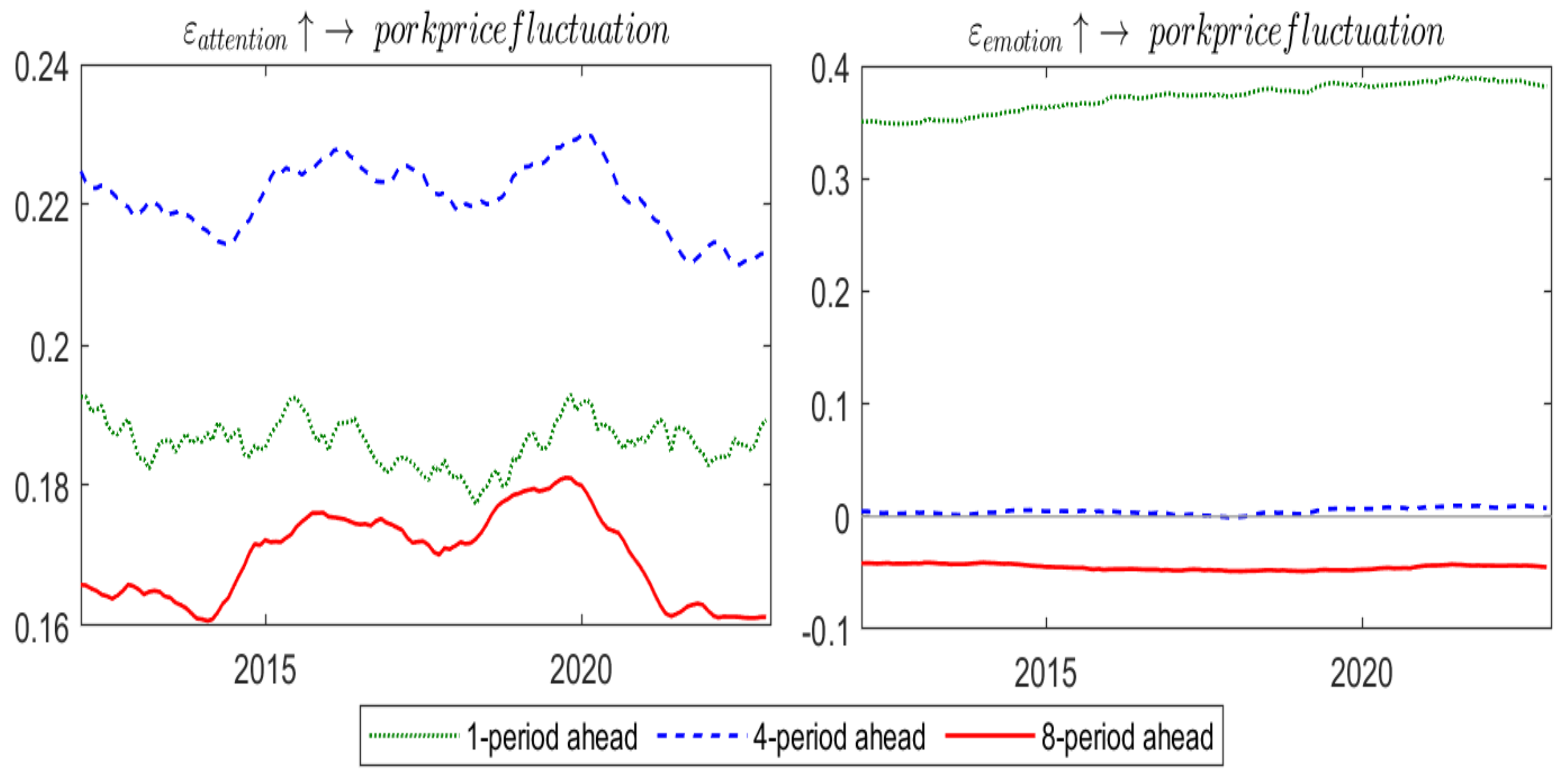
| Variable | Form | ADF Test Value | p | Stationarity |
|---|---|---|---|---|
| Pork price fluctuations | (C, T, 0) | −5.268 | 0.0000 | Stationary |
| (0, 0, 0) | −5.007 | 0.0002 | Stationary | |
| Public concern | (C, T, 0) | −7.502 | 0.0000 | Stationary |
| (0, 0, 0) | −7.609 | 0.0000 | Stationary | |
| Negative sentiment | (C, T, 0) | −6.450 | 0.0000 | Stationary |
| (0, 0, 0) | −6.283 | 0.0001 | Stationary |
| Variable | Zivot-Andrews Test Value | Stationarity |
|---|---|---|
| Pork price fluctuations | −5.985 *** | Stationary |
| Public concern | −6.118 *** | Stationary |
| Negative sentiment | −6.886 *** | Stationary |
| lag | LL | LR | df | p | FPE | AIC | HQIC | SBIC |
|---|---|---|---|---|---|---|---|---|
| 0 | −255.962 | 0.244 | 4.264 | 4.283 | 4.310 | |||
| 1 | −223.212 | 65.500 | 4.000 | 0.000 | 0.152 | 3.789 | 3.845 * | 3.927 * |
| 2 | −215.938 | 14.547 * | 4.000 | 0.006 | 0.144 | 3.735 | 3.828 * | 3.966 |
| 3 | −211.632 | 8.613 | 4.000 | 0.072 | 0.143 * | 3.729 * | 3.861 | 4.053 |
| 4 | −209.988 | 3.287 | 4.000 | 0.511 | 0.149 | 3.768 | 3.937 | 4.184 |
| 5 | −209.470 | 1.037 | 4.000 | 0.904 | 0.157 | 3.826 | 4.032 | 4.334 |
| 6 | −207.492 | 3.955 | 4.000 | 0.412 | 0.163 | 3.859 | 4.103 | 4.460 |
| 7 | −207.068 | 0.849 | 4.000 | 0.932 | 0.173 | 3.918 | 4.200 | 4.612 |
| 8 | −205.445 | 3.245 | 4.000 | 0.518 | 0.180 | 3.958 | 4.277 | 4.743 |
| 9 | −202.722 | 5.446 | 4.000 | 0.244 | 0.184 | 3.979 | 4.335 | 4.857 |
| 10 | −200.453 | 4.537 | 4.000 | 0.338 | 0.190 | 4.008 | 4.402 | 4.978 |
| Parameter | Mean | Standard | 95% Confidence Interval | Geweke Value | Invalid Factor |
|---|---|---|---|---|---|
| sb1 | 0.003 | 0.003 | [0.002, 0.012] | 0.000 | 7.720 |
| sb2 | 0.003 | 0.002 | [0.002, 0.009] | 0.000 | 8.090 |
| sa1 | 0.028 | 0.006 | [0.022, 0.043] | 0.000 | 2.360 |
| sa2 | 0.073 | 0.035 | [0.017, 0.120] | 0.000 | 23.550 |
| sh1 | 0.021 | 0.009 | [0.011, 0.043] | 0.000 | 12.130 |
| sh2 | 0.062 | 0.025 | [0.021, 0.102] | 0.123 | 21.100 |
| Topic Number | Topic Name | Topic Top 5 High Probability Feature Words |
|---|---|---|
| 1 | Disease transmission | infection, infectious disease, disease, transmission, treatment |
| 2 | Vaccine technology | vaccine, enterprise, technology, industry, technology |
| 3 | Disease prevention and control | prevention and control, immunization, measures, quarantine, monitoring |
| 4 | Industry development | cycle, capacity, industry, rise, growth |
Disclaimer/Publisher’s Note: The statements, opinions and data contained in all publications are solely those of the individual author(s) and contributor(s) and not of MDPI and/or the editor(s). MDPI and/or the editor(s) disclaim responsibility for any injury to people or property resulting from any ideas, methods, instructions or products referred to in the content. |
© 2025 by the authors. Licensee MDPI, Basel, Switzerland. This article is an open access article distributed under the terms and conditions of the Creative Commons Attribution (CC BY) license (https://creativecommons.org/licenses/by/4.0/).
Share and Cite
Li, F.; Li, H.; Dai, X.; Ren, H.; Li, H. Does Online Public Opinion Regarding Swine Epidemic Diseases Influence Fluctuations in Pork Prices?—An Analysis Based on TVP-VAR and LDA Models. Agriculture 2025, 15, 730. https://doi.org/10.3390/agriculture15070730
Li F, Li H, Dai X, Ren H, Li H. Does Online Public Opinion Regarding Swine Epidemic Diseases Influence Fluctuations in Pork Prices?—An Analysis Based on TVP-VAR and LDA Models. Agriculture. 2025; 15(7):730. https://doi.org/10.3390/agriculture15070730
Chicago/Turabian StyleLi, Fei, Huishang Li, Xin Dai, Hongjie Ren, and Huaiyang Li. 2025. "Does Online Public Opinion Regarding Swine Epidemic Diseases Influence Fluctuations in Pork Prices?—An Analysis Based on TVP-VAR and LDA Models" Agriculture 15, no. 7: 730. https://doi.org/10.3390/agriculture15070730
APA StyleLi, F., Li, H., Dai, X., Ren, H., & Li, H. (2025). Does Online Public Opinion Regarding Swine Epidemic Diseases Influence Fluctuations in Pork Prices?—An Analysis Based on TVP-VAR and LDA Models. Agriculture, 15(7), 730. https://doi.org/10.3390/agriculture15070730






